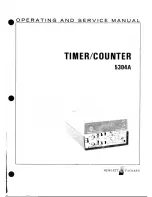
___________________________________________________________________________________________________________
Rev.
7/10/15 Page 1 of 4
Skytech TM/R-AF1-1
Model: TM/R-AF1-1
INSTALLATION AND OPERATING INSTRUCTIONS
SINGLE-FUNCTION WIRELESS REMOTE CONTROL SYSTEM
FOR OPERATING VALVES WITH ON/OFF LATCHING SOLENOIDS
INTRODUCTION
This SKYTECH remote Wireless Wall Timer system was developed to provide safe, reliable, and user-friendly remote control system
for gas heating appliances. The system can be operated manually from the transmitter. The system operates on one of 65,536 security
codes that are programmed into the transmitter at the factory.
WALL TIMER
The wall timer operates on a (2) 3V button cell batteries (included) made
specifically for remote controls and electronic lighters. Before using the wall
transmitter, install the two (2) 3V button cell batteries. Follow instructions below.
The wall timer has a 30 min, 60 min, 120 min, and OFF buttons. When any of the
buttons on the wall timer is pressed, a signal light on the wall timer illuminates
briefly to verify that a signal has been sent. If the signal light does not illuminate,
check the batteries. Upon initial use, there may be a delay of 5-seconds before
the remote receiver will respond to the wall timer.
TO INSTALL BATTERIES
1.
Remove face from backing plate by insetting a small screwdriver into
the small slot at the top or bottom of the faceplate as shown below then
snap OFF.
2.
Locate the (2) holders for the 3V button cell batteries.
3.
Place the button cell batteries into the battery holders and snap into
place. (Make sure that the batteries are installed with the (+) plus side
as shown to the right.
4.
After the batteries are installed replace the faceplate on the base.
TO REMOVE THE BATTERIES
1.
Remove face from backing plate by insetting a small screwdriver into
the small slot on the side at the top or bottom of the faceplate as shown
to the right then snap OFF.
2.
Locate the (2) holders for the 3V button cell batteries.
3.
Insert a small screwdriver into the slot at the button cell battery and pop
the battery out (Slots shown in picture above).
4.
After the batteries are installed replace the faceplate.
IF YOU CANNOT READ OR UNDERSTAND THESE INSTALLATION INSTRUCTIONS DO NOT
ATTEMPT TO INSTALL OR OPERATE
f i r e - p a r t s . c o m






















